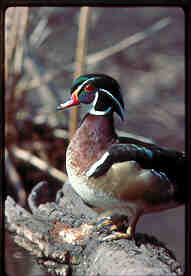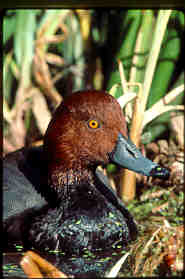Waterfowl Numbers Up
IOWA HUNTING SEASON SHOULD BE DUCKY
By Lowell Washburn
Iowa Department of Natural Resources
Posted: August 19, 2003
DES MOINES--When Iowa hunters take to the state's public wetlands
this fall, they are likely to encounter more migrating ducks than they
did one year ago.
According to DNR Waterfowl Biologist, Guy Zenner, all of the
continent's 10 most commonly surveyed duck species showed an increase
during this year's nesting season. For several species, the gains were
dramatic.

The number of blue-winged teal increased by 31 percent over last
year, while pintails jumped 43 percent. The number of shovelers
increased by 56 percent and the breeding populations of green-winged
teal, gadwalls, redhead, and canvasback ducks all showed gains of around
15 percent over 2002. The number of scaup and mallard ducks showed a
more moderate increase of 6 percent over last year. The number of wigeon
rose by 9 percent.
According to the U.S. Fish & Wildlife Service, the 2003 population of
mallard, gadwall, teal, redhead, and canvasback ducks is now at or above
the long term [1955-2003] average for those species.
"FOR IOWA WATERFOWL HUNTERS, any increase in duck numbers is welcome
news," said Zenner. "But this year, duck numbers are up quite
significantly from what was surveyed during the spring of 2002.
Consequently, the outlook for this year's fall flight is very positive."

But this year's sudden increase in total duck numbers comes as no
surprise, says Zenner. Given the greatly improved spring habitat
conditions that greeted migrating ducks during April and May, it would
have been hard for bird numbers not to increase.
Simply put, ducks need water to nest. An abundance of spring ponds
generally means a surge in production. When drought conditions cause
spring ponds to disappear, waterfowl populations decline.
During this year's spring habitat surveys, May pond counts increased
by 145 percent across the principal nesting grounds of prairie Canada.
Pond counts in the grasslands of North Dakota, South Dakota, and eastern
Montana increased by more than 30 percent.
"It would have been very unusual to have pond numbers increase this
dramatically and not have duck numbers follow that trend," said Zenner.
"Last winter was extremely dry across much of southern Canada. During
April, those areas were hit with a combination of heavy snow storms and
abundant rainfall. The ducks arrived and took full advantage of the
improved habitat."
BUT WILDLIFE BIOLOGISTS ARE QUICK TO CAUTION hunters against placing
too much emphasis on total duck numbers. That, they say, can be
misleading.
"What waterfowl hunters living in places like Minnesota or Iowa need
to keep in mind is that hunting success will depend much more on
developing fall weather patterns and regional habitat [marsh] conditions
than it will on the total number of ducks coming out of Canada," said
Zenner.
"Right now, conditions are extremely dry across much of the state. In
the marsh country of north central and northwest Iowa, persistent heat
and a lack of rainfall have degraded wetlands significantly during the
past month. We need substantial rainfall to raise wetland water levels
and pull birds into Iowa during migration. Otherwise, migrants could
just fly over or even bypass those areas this fall.
"However, it should also be noted that a couple of good cloud bursts
could turn things around. With favorable moisture patterns, the whole
picture could change completely within a few days -- we've seen that
before. At this point, we'll just have to wait and see what the weather
does.
"What I can say is that regardless of where a person plans to hunt
this fall, some preseason scouting is definitely in order," said Zenner.
|